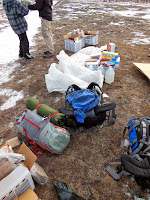 |
| September 25, 2013. |
My health recovered and I was in
full teaching mode on September 24. My
Grade 10 Social Studies students began a new unit titled Staking the Claim: Dreams, Democracy, and Canadian Inuit. This would be my second time teaching the
unit. This educational resource sees
students learning about the history of Inuit Land Claims, a lengthy process
that began in the 1970s and resulted in the signing of four land claim
agreements with the Canadian federal government many years later. The unit mostly focuses on the Nunavut Land Claims Agreement (1993), the creation of the territory of Nunavut (1999), and
the Inuit people & organizations who were involved in the negotiations.
The first three background chapters
focus on how the Inuit lived out on the land without any outside help, the
arrival of Europeans, and how Europeans exerted dominance over the Inuit
through force and legislation. My
students also watched the Canadian drama film, Before Tomorrow, an Inuit movie made by the same people who made Antanarjuat: The Fast Runner. Before Tomorrow is the third movie in the
Nunavut Trilogy, and takes place in the Nunavik region of northern Quebec
during the 1840s. The second film in the
trilogy is The Journals of Knud Rasmussen.
In Grade 11 Social Studies, we were
deep in the study of the First World War, the so-called "war to end all
wars." For late September and early
October, I had my students examine Canada's contributions to the war effort at
home and on the battlefields. We looked
at the Battles of Ypres, the Somme, and Passchendaele, the munitions industry,
the role of women, the Halifax Explosion of 1917, and the mistreatment of
German, Austrian, and Italian immigrants who were branded as 'enemy aliens'. As well, we examined the horrors of trench
warfare, shellshock, and the massive loss of lives in "no-man's
land". For the film study, we
watched Passchendaele, a Canadian war
film made by Canadian actor & director Paul Gross.
My drummers were tested on seven
basic & intermediate drum rudiments on the last week of September. They all did very well. We continued to look at rhythms and warm up
exercises in the VicFirth textbook, a routine that some were finding too
repetitive, but I stressed the need to continually review them. My drummers only have time to practice at
school because they do not have sticks and practice pads at home, and reviewing
the exercises strengthens their stick handling and memory.
 |
| October 1, 2013 |
When October arrived, I introduced a
new piece for them to learn for Halloween, called Zombie Squirrels. Written by Cassidy Byars, this short beginner
piece is written for snares, bass drums, quads, and cymbals. I found the piece on a drum music sharing website and thought it was interesting enough for the drummers to perform. They have a month to get ready so we'll see
what happens on Halloween.
For Grade 12 Social Studies, my
students studied the topic of collectivism in depth and had a review test. Most
of them did fairly well. I also gave
them time in class to do research on their Social Studies Projects. The next big item for them to complete is a
formal essay on their chosen topics.
On September 26, a group of high
school students completed repainting the large Arctic Bay, Nunavut sign that
sits on the face of a large rocky hill.
The sign is actually a large rock formation and was made in the early 20th
century.
Despite the arrival of October,
there was still no snow on the ground nor ice in the bay. (A far cry from what it is now). Upon mentioning this to my students, they
said I spoke too soon; the bay would start freezing in a matter of days. The temperature hovered slightly beneath 0ºC
and the sunrises over the southern mountains were picturesque.
 |
| Tara research vessel. |
On October 2nd, the town welcomed
Tara, a large French scientific research vessel for Tara Expeditions. The ship is 36 metres in length, 10 metres
wide, and weighs 120 tons. It is manned
by a crew of five and can host up to six scientists. Beginning in 2003, Tara Expeditions is a
French non-profit organization that conducts scientific research on the world's
oceans and climate change. Their latest expedition to circumnavigate the Arctic ocean began in May and will end in
November of this year. By then, the crew
& scientists will have travelled 25,000km, "study[ing] the Arctic
ecosystem before a probable climate change." Check out the links in this paragraph for
more information about Tara Expeditions and its mandate.
The French scientists came ashore to
give a presentation to the high school students of Inuujaq School. We all shuffled into the science room after
lunch and watched & listened to a PowerPoint presentation about the 5Ws & 1H of the expedition. The
presentation was filmed by the 'onboard' journalist. You can find video here (dated 3/10/2013). The students showed much interest and asked
plenty of questions. I was surprised to
learn that the entire expedition would cost $2.5 million Canadian dollars. The scientific adventurers left Arctic Bay
the following day for Pond Inlet.
 |
| October 5, 2013 |
Arctic Bay was briefly covered by
snow on October 5th, but melted a day or two later. The scene reminded me of Ottawa in November. The CCGS Louis S. St Laurent, revisited the
town between October 5 - 7 for the last time.
While I photographed the heavy icebreaker, I began to notice ice forming
in the bay. The onset of winter was fast
approaching, but there was something bigger and much more exciting coming to
town: high school graduation.
 |
| October 9, 2013 |











































